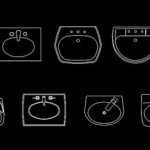How To Remove a Bathroom Sink Valve
Removing a bathroom sink valve might seem like a daunting task, but with the right tools and a systematic approach, it can be accomplished effectively. This article outlines the necessary steps to successfully remove a bathroom sink valve, enabling homeowners to tackle plumbing repairs confidently.
Preparation is Key
Before beginning any plumbing work, preparation is crucial for a smooth and trouble-free process. This involves gathering the necessary tools and taking precautionary measures to protect the work area.
*
Gather Necessary Tools:
Having all the required tools readily available will prevent interruptions and streamline the process. Essential tools include a basin wrench, adjustable wrench, screwdriver set, pliers, bucket, and towels. *Shut Off the Water Supply:
Turning off the water supply to the sink prevents accidental flooding during valve removal. Locate the shut-off valves under the sink, usually designated with hot and cold markings, and turn them clockwise until fully closed. *Drain the Sink:
Residual water in the sink can create a mess during the valve removal process. Drain the sink completely by opening the drain stopper or removing the pop-up assembly. *Protect the Sink Basin:
Placing a towel or soft cloth in the sink basin protects the surface from scratches or damage caused by dropped tools or components.Accessing the Valve
Accessing the bathroom sink valve requires understanding its location and carefully detaching connected components. The following steps outline how to gain access to the valve effectively.
*
Disconnect the Water Supply Lines:
Using an adjustable wrench, carefully loosen and disconnect the hot and cold water supply lines connected to the valve. Hold the valve body steady with one hand while loosening the nuts to prevent twisting and potential damage to the pipes. Place a bucket underneath to catch any remaining water in the lines. *Remove the Retaining Nut/Clip:
Bathroom sink valves are typically secured to the sink with a retaining nut or clip located underneath the sink basin. Depending on the type of valve, a basin wrench or deep socket wrench may be necessary to remove this nut/clip. *Detach the Lift Rod or Pop-Up Assembly:
Most bathroom sink valves are connected to a lift rod or pop-up assembly that controls the drain stopper. Disconnect this linkage from the valve body, usually by unscrewing or unclipping it.Removing the Valve
With the connections detached and the valve accessible, the final step involves carefully removing the valve from the sink.
*
Loosen the Valve Body:
Depending on the valve type, it may be threaded directly into the sink or held in place by a mounting nut. Use the appropriate wrench to loosen and remove the valve body from the sink. *Clean the Valve Area:
After removing the old valve, take the opportunity to clean the valve area on the sink. Remove any old putty, sealant, or debris to ensure a proper seal for the new valve installation.Troubleshooting Potential Issues
Occasionally, difficulties may arise during the valve removal process. This section addresses common issues and provides solutions for overcoming them.
*
Corroded Connections:
If the nuts connecting the water supply lines are corroded and difficult to loosen, penetrating oil can be applied to help break down the corrosion. Allow the oil to penetrate for a few minutes before attempting to loosen the nuts again. *Stubborn Retaining Nut/Clip:
If the retaining nut or clip is difficult to remove, ensure the correct tool is being used and apply steady pressure. Avoid excessive force, which can damage the sink. If necessary, a penetrating oil can be used here as well. *Seized Valve Body:
If the valve body is seized and won't budge, applying heat with a heat gun can help loosen it. Be cautious not to overheat the surrounding area. If heat doesn't work, a specialized valve puller tool may be necessary.Choosing a Replacement Valve
Selecting the correct replacement valve is crucial for proper functionality and compatibility with the sink. Consider the following points when choosing a new valve.
*
Valve Type:
Identify the type of valve being replaced (e.g., compression, cartridge, ceramic disc) to ensure the new valve is compatible. *Size and Configuration:
Measure the existing valve and note the configuration of the inlets and outlets to select a replacement valve with matching dimensions. *Finish and Style:
Choose a replacement valve that complements the existing bathroom fixtures in terms of finish and style.Safety Precautions
Throughout the valve removal process, prioritizing safety is paramount. Observe the following precautions to mitigate potential risks.
*
Eye Protection:
Wear safety glasses to protect eyes from debris or splashing water. *Gloves:
Wear gloves to protect hands from dirt and potential contaminants. *Proper Ventilation:
Ensure adequate ventilation in the bathroom to prevent the buildup of fumes from cleaning agents or penetrating oils.
How To Replace A Leaking Shutoff Valve Under Sink

How To Replace A Bathroom Faucet Home Repair Tutor

How To Remove A Bathroom Faucet

How To Replace A Shutoff Valve Diy Family Handyman

How To Install Water Shut Off Valve For Sinks

How To Replace Valve Seats The Home Depot

How To Replace A Flowtite Push Pull Valve With Standard Shut Off For Dishwasher

How To Replace A Bathroom Faucet Tinged Blue
How To Get A Bathroom Sink Plug Removed When It Won T Un Quora

How To Fix A Leaking Water Supply Shut Off Valve Easy Diy For Beginners
Related Posts







